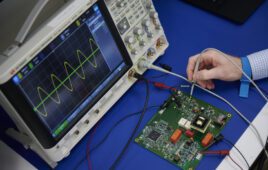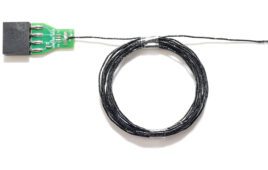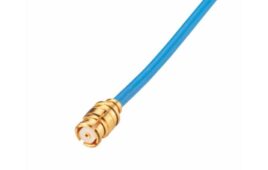Microwave ablation systems provide nonsurgical methods for treating internal cancers and tumors. This application requires the right cable assemblies to achieve optimum performance.
Carrie Obedzinski, Times Microwave Systems

Radiofrequency ablation (RFA) and microwave ablation (MWA) respectively use electrical and microwave energy to heat precise areas and destroy abnormal cells. (Image courtesy of Times Microwave Systems.)
Radiofrequency (RF) and microwave energy carry many modern messages as part of broadcast and wireless communications but are also potentially life-saving medical tools. Within ablation systems, radiofrequency and microwave energy can penetrate a patient’s body to heat and destroy tumors, avoiding invasive surgical procedures and long recuperation times.
These systems feature advanced software and artificial intelligence (AI) methods to treat tumors with minimal damage to surrounding tissues, but they still depend on many different types of RF/microwave components. This includes coaxial cable assemblies and often-invasive antennas formed of coaxial cables. The performance of these cables is crucial because a life may depend on it.
How they work
Radiofrequency and microwave ablation systems use tiny antennas or probes projected onto a patient’s body to focus electromagnetic (EM) energy on tissues to be treated.
To reach malignant tissue with adequate EM energy, small-diameter coaxial cables are used to form finely polished antennas or probes and to transfer the EM energy from a source to the antenna. Those cables should provide performance levels that help RF and microwave ablation systems destroy the targeted malignant tissues. Shielded coaxial cables with low loss at the target frequency are typically used to preserve as much of the high-frequency source energy as possible; high loss in these interconnection cables will result in RF/microwave energy lost through heating the cables rather than heating the tumor.
How they differ
The smaller wavelengths and higher frequencies of microwave ablation systems allow deeper heating penetration and wider area heating coverage than radiofrequency ablation. Ablation systems typically operate in the ISM (industrial, scientific, medical) bands at frequencies of 915 MHz, 2.45 GHz and 5.80 GHz and at power levels of 50 W (+47 dBm) or more.
That EM energy is coupled to the antenna or probe by means of a low-loss coaxial cable assembly. Higher, millimeter-wave frequencies (through 60 and 70 GHz) have been used in ablation systems for special treatment, although the difficulty of generating EM power at these higher frequencies makes the component selection for those microwave ablation systems even more critical. That is, the energy loss of a coaxial cable increases with increasing frequency.
Cable considerations
The coaxial cables used in ablation systems and other high-frequency medical electronic systems are typically flexible cables capable of wide-band frequency coverage. They should be specified carefully according to parameters that can affect RF and microwave ablation system performance. Those parameters include loss/attenuation, phase stability, shielding, passive intermodulation (PIM) and velocity of propagation (VP).
Cable loss or attenuation is a function of its dielectric and conductive materials, diameter, length and the operating frequency. Loss increases with frequency and excessive loss can cause the temperatures of the cable and ablation antenna to rise, resulting in unwanted heating of tissues along the signal path to the antenna. In some cases, it may require some form of cooling to offset the cable temperature rise caused by handling too much power with too much loss/attenuation. Cable loss is typically characterized in dB/ft. It decreases with larger cable diameters, although they are less likely to reach a patient’s malignant tissue area.
Phase must be extremely stable along the EM power path in an RF or microwave ablation system to maintain a tightly focused energy beam on a malignant tissue. Multiple cables are used in phased arrays to create focused energy on the tumor. Phase deviations can occur with cable flexure and with temperature changes, which are usually measured and compared from cable to cable in terms of ppm/°C. Phase can also vary with impedance mismatches from a nominal 50 Ω, which are measured by variations in voltage standing wave ratio (VSWR) with frequency.
Other performance parameters include the effects of propagation delays and velocity of propagation through the cables, passive intermodulation and its impact on signal integrity, and shielding effectiveness, which describes how well a cable assembly is isolated from surrounding electrical devices and energy sources.
Shielding effectiveness is key because high energy levels could interfere with other systems using the same frequencies, such as WiFi.
RF and microwave ablation systems make huge differences in the health and lives of many patients. Coaxial cable assemblies are among the high-frequency components that make RFA and MWA systems possible. When they perform properly, they can be lifesavers.
Carrie Obedzinski is business development manager for Times Microwave Systems. She has more than 20 years’ experience in sales and product management, focusing mainly on interconnect solutions and management.
The opinions expressed in this blog post are the author’s only and do not necessarily reflect those of Medical Design and Outsourcing or its employees.




